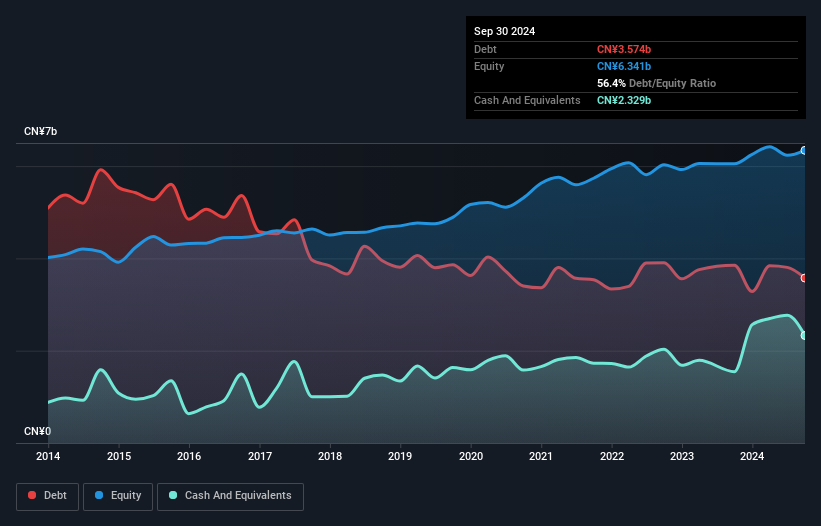Howard Marks put it nicely when he said that, rather than worrying about share price volatility, 'The possibility of permanent loss is the risk I worry about... and every practical investor I know worries about.' So it seems the smart money knows that debt - which is usually involved in bankruptcies - is a very important factor, when you assess how risky a company is. Importantly, Shanghai Zijiang Enterprise Group Co., Ltd. (SHSE:600210) does carry debt. But the real question is whether this debt is making the company risky.
When Is Debt A Problem?
Debt is a tool to help businesses grow, but if a business is incapable of paying off its lenders, then it exists at their mercy. Part and parcel of capitalism is the process of 'creative destruction' where failed businesses are mercilessly liquidated by their bankers. However, a more frequent (but still costly) occurrence is where a company must issue shares at bargain-basement prices, permanently diluting shareholders, just to shore up its balance sheet. Of course, the upside of debt is that it often represents cheap capital, especially when it replaces dilution in a company with the ability to reinvest at high rates of return. When we examine debt levels, we first consider both cash and debt levels, together.
What Is Shanghai Zijiang Enterprise Group's Debt?
As you can see below, Shanghai Zijiang Enterprise Group had CN¥3.57b of debt at September 2024, down from CN¥3.85b a year prior. On the flip side, it has CN¥2.33b in cash leading to net debt of about CN¥1.25b.

How Strong Is Shanghai Zijiang Enterprise Group's Balance Sheet?
 Zooming in on the latest balance sheet data, we can see that Shanghai Zijiang Enterprise Group had liabilities of CN¥6.68b due within 12 months and liabilities of CN¥1.52b due beyond that. Offsetting these obligations, it had cash of CN¥2.33b as well as receivables valued at CN¥2.10b due within 12 months. So it has liabilities totalling CN¥3.77b more than its cash and near-term receivables, combined.
Zooming in on the latest balance sheet data, we can see that Shanghai Zijiang Enterprise Group had liabilities of CN¥6.68b due within 12 months and liabilities of CN¥1.52b due beyond that. Offsetting these obligations, it had cash of CN¥2.33b as well as receivables valued at CN¥2.10b due within 12 months. So it has liabilities totalling CN¥3.77b more than its cash and near-term receivables, combined.
Shanghai Zijiang Enterprise Group has a market capitalization of CN¥10.4b, so it could very likely raise cash to ameliorate its balance sheet, if the need arose. However, it is still worthwhile taking a close look at its ability to pay off debt.
In order to size up a company's debt relative to its earnings, we calculate its net debt divided by its earnings before interest, tax, depreciation, and amortization (EBITDA) and its earnings before interest and tax (EBIT) divided by its interest expense (its interest cover). The advantage of this approach is that we take into account both the absolute quantum of debt (with net debt to EBITDA) and the actual interest expenses associated with that debt (with its interest cover ratio).
Shanghai Zijiang Enterprise Group has a low net debt to EBITDA ratio of only 0.99. And its EBIT easily covers its interest expense, being 45.5 times the size. So you could argue it is no more threatened by its debt than an elephant is by a mouse. Fortunately, Shanghai Zijiang Enterprise Group grew its EBIT by 6.5% in the last year, making that debt load look even more manageable. When analysing debt levels, the balance sheet is the obvious place to start. But it is future earnings, more than anything, that will determine Shanghai Zijiang Enterprise Group's ability to maintain a healthy balance sheet going forward. So if you're focused on the future you can check out this free report showing analyst profit forecasts.
Finally, a business needs free cash flow to pay off debt; accounting profits just don't cut it. So it's worth checking how much of that EBIT is backed by free cash flow. During the last three years, Shanghai Zijiang Enterprise Group generated free cash flow amounting to a very robust 81% of its EBIT, more than we'd expect. That positions it well to pay down debt if desirable to do so.
Our View
The good news is that Shanghai Zijiang Enterprise Group's demonstrated ability to cover its interest expense with its EBIT delights us like a fluffy puppy does a toddler. And that's just the beginning of the good news since its conversion of EBIT to free cash flow is also very heartening. When we consider the range of factors above, it looks like Shanghai Zijiang Enterprise Group is pretty sensible with its use of debt. That means they are taking on a bit more risk, in the hope of boosting shareholder returns. There's no doubt that we learn most about debt from the balance sheet. But ultimately, every company can contain risks that exist outside of the balance sheet. Case in point: We've spotted 1 warning sign for Shanghai Zijiang Enterprise Group you should be aware of.
If you're interested in investing in businesses that can grow profits without the burden of debt, then check out this free list of growing businesses that have net cash on the balance sheet.
Have feedback on this article? Concerned about the content? Get in touch with us directly. Alternatively, email editorial-team (at) simplywallst.com.
This article by Simply Wall St is general in nature. We provide commentary based on historical data and analyst forecasts only using an unbiased methodology and our articles are not intended to be financial advice. It does not constitute a recommendation to buy or sell any stock, and does not take account of your objectives, or your financial situation. We aim to bring you long-term focused analysis driven by fundamental data. Note that our analysis may not factor in the latest price-sensitive company announcements or qualitative material. Simply Wall St has no position in any stocks mentioned.
